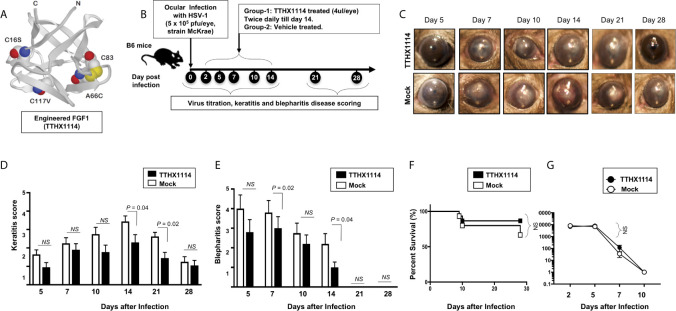Figure 1.
Effect of FGF-1 treatment on corneal disease during acute corneal HSV-1 infection: (A) Structure of FGF-1, an engineered FGF-1 known to aid in corneal epithelial wound healing. (B) Experimental plan to assess the effect of FGF-1 topical eye treatment in HSV-1 (McKrae) infected B6 mice is shown. Mice were mock treated/treated with FGF-1 (1.6 ng/eye, twice a day) from day1 post-infection with HSV-1 McKrae (5X105/eye). Mice were scored at day 5, 7, 10,14, 21, 28 for pathological symptoms of Keratitis and blepharitis after infection with 5X 105 pfu/eye of HSV-1 McKrae, mock/treated with FGF-1 from day1 p.i. Stromal keratitis was scored as 0- no disease; 1- cloudiness, some iris detail visible; 2- iris detail obscured; 3- cornea totally opaque; and 4- cornea perforation. Blepharitis was scored as 0- no disease; 1- puffy eyelids; 2- puffy eyelids with some crusting; 3- eye swollen shut with severe crusting; and 4- eye completely swollen shut. Keratitis score and Blepharitis score in mice mock/treated with FGF-1 during corneal HSV-1 infection. (C) Representative eye pictures of mice mock treated/treated with FGF-1 from day1 after infection with HSV-1 McKrae. Graph showing corresponding keratitis (D) and blepharitis score (E) at day 7, 10 14 p.i. Data represent the mean score from experiment with a total of 10 mice per group. (F) Survival plot of mice mock treated/treated with FGF-1 (1.6 ng/eye) twice a day from day1 post-infection with HSV-1 McKrae (5X105/eye). (G) Graph showing virus titre in eye swabs of TTHX1114 and mock treated mice, estimated by plaque assay. NS, not significant.

